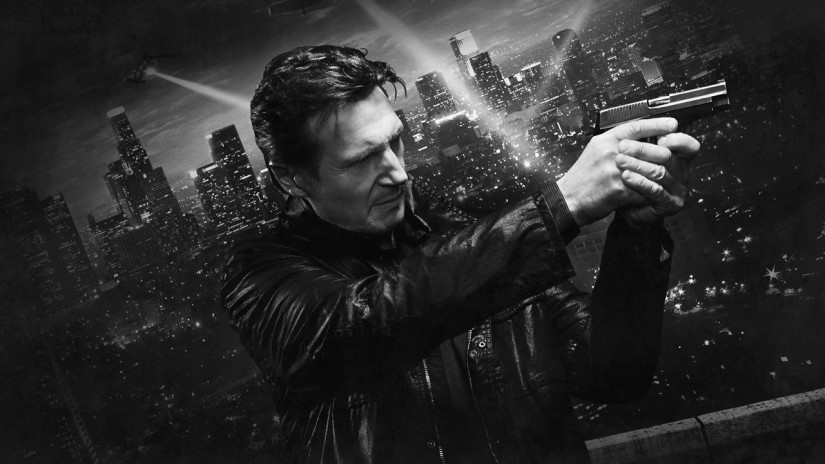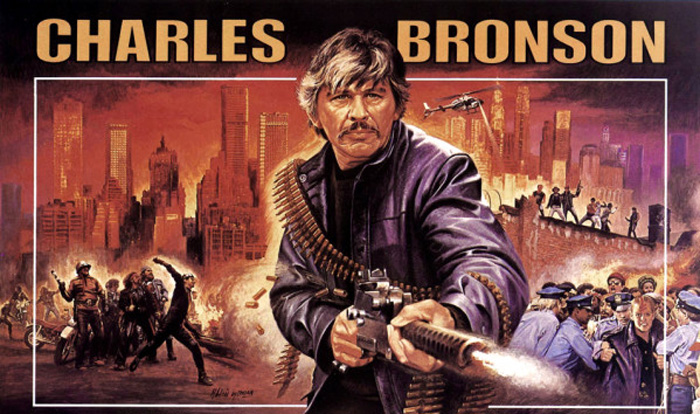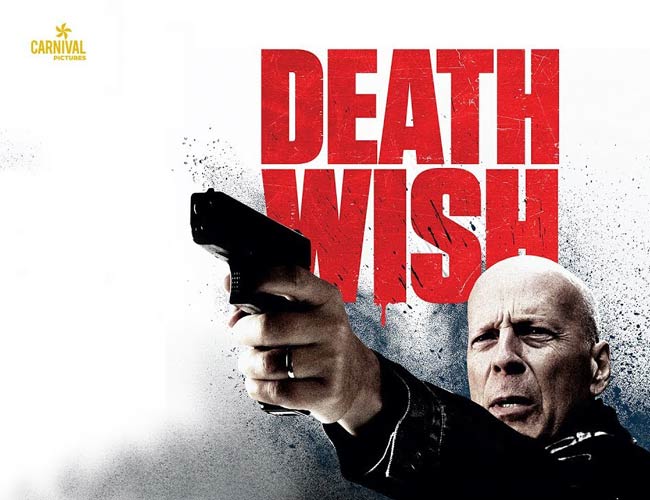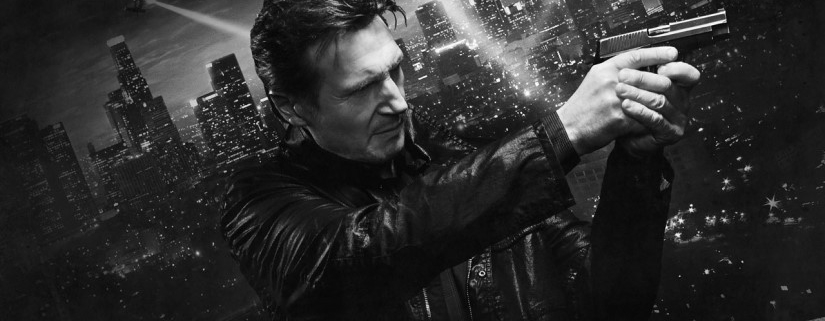On Liam Neeson and the Philosophy of the White Vigilante

Jonathan Bowden once memorably argued that right wing ideas can be exiled from the political and social mainstream but never totally destroyed, being merely abstracted and displaced into other areas of culture. One such area, he argued, was film, and in certain filmic representations we can still see the semi-self-conscious acting out of the often violent, often suppressed tendencies and latent potentialities of Western man. Bowden cited as examples the number of movie posters depicting a lone White male, gun in hand, gazing into the distance. The movies these posters advertise invariably call upon the themes of a now much-maligned White masculinity. They feature males with singular and non-dialectical mentalities, possessing moral worldviews unclouded by compromise. In a blurring of stark individualism and concern for the group as a whole, these characters often live (and behave) at the margins of the society they go on to protect. They possess an open disdain for social permissiveness, bureaucracy, and procedure, and, finally, they are the spartan, right wing existentialist practitioners of a violent urban vigilantism. They are part of a genre described by one Marxist critic as “repugnantly fascist.”

Charles Bronson in Death Wish 3
The origins of the most modern incarnation of this style of film can probably be discerned in Death Wish (1974).[1] Starring Charles Bronson as mild-mannered architect Paul Kersey, the film charts the transformation of an everyman into violent angel of death following the rape of his daughter and the murder of his wife. The context of the film, which is crucial to the genre more generally, is that the urban environment is a dangerous wellspring of crime and degeneracy and, perhaps most crucial of all, that its chaotic nature lends it a frontier aspect. The frontier aspect of the modern city is necessarily and inescapably racial, but is also political, in the sense that just as all geographical paths to the city are porous, so are the social boundaries within it. Races blend in dangerous criminal cocktails, cops walk fine lines between justice and corruption, and morality is reduced to its most basic and primal form. The city is therefore somehow pre-modern as well as postmodern, representing, despite its technologically advanced facade, a regression to primitive moral states and therefore requiring pre-civilized methods of retributive justice. For Paul Kersey, this meant the summary execution of a series of criminals that the established police force manifestly failed to control and punish.
Kersey’s rampage tapped into a well of feeling in the viewing public, and it is extremely telling that the film was mostly panned by critics who were appalled by its message, while being wildly successful at the box office, making a profit of almost $100 million, adjusting for inflation. It resonated with an America appalled at urban crime, sensitive to cultural degeneration, and uneasy with demographic and racial changes. Because of the commercial success of the formula and its ability to act as a cathartic but ultimately harmless (and potentially titillating) diversion for the anxieties of White America, Jewish producers were keen to exploit the genre. The increasingly gratuitous Death Wish sequels were produced by the Israeli cousins Menahem Golan and Yoram Globus, for whom, one reviewer states, “quick, dirty, and cheap exploitation came naturally.”

Bruce Willis as Paul Kersey in the 2018 remake of Death Wish
The formula also rather predictably spawned countless imitations, the most recent of which is the Taken trilogy (2008–2014) starring Liam Neeson as a father leaving a trail of death and destruction in his attempt to rescue his daughter from Albanian sex traffickers, along with numerous other films starring Neeson (heir apparent to Charles Bronson, Clint Eastwood, et al.) that are mere variations on the same theme of retributive vigilante justice. As part of the publicity effort for his most recent lone vigilante film, Cold Pursuit, Neeson gave a now-infamous interview for the Independent touching on issues of race and revenge that, I will argue, succinctly opens up the inner philosophical and social truths of the genre he has come personally to embody, while also exposing its exploitative and diversionary aspects.
During the course of the interview for Cold Pursuit, Neeson set about explaining how his latest character turns to anger: “There’s something primal — God forbid you’ve ever had a member of your family hurt under criminal conditions. … I’ll tell you a story. This is true.” Neeson then explained that many years previously he had returned from working overseas to find out that a loved one had been raped. “She handled the situation of the rape in the most extraordinary way,” Neeson says. “But my immediate reaction was … I asked, did she know who it was? No. What colour were they? She said it was a black person … I went up and down areas with a cosh, hoping I’d be approached by somebody — I’m ashamed to say that — and I did it for maybe a week, hoping some ‘black bastard’ would come out of a pub and have a go at me about something, you know? So that I could … kill him.”
These few sentences were sufficient to shock the interviewer, Clémence Michallon, as well as prompting his nearby co-star Tom Bateman to utter a stunned “Holy shit.” A media frenzy then ensued on publication. Unquestionably, the most controversial aspect of Neeson’s revelation was the racial element, especially his confession to asking almost immediately about the racial identity of the rapist. In 2017 I penned a piece on the Finsbury Park mosque attack in which I framed the incident as being an inadvertent and hamfisted rebellion against the idea that revenge couldn’t even be contemplated. The shock accompanying Neeson’s comments are broadly within the same framework — postmodern liberalism simply cannot conceive that Whites could perceive of themselves as having interests, as being victimized, and as potentially seeking revenge for that victimization. Revenge for being victimized by a Black person and potentially seeking race-based revenge for that victimization is even more beyond the pale.
Neeson’s line of questioning with his unfortunate female loved one is, in light of all available statistics, admirably logical and well-informed. As soon as he determined she had been raped by a stranger, the statistical probability that she had been raped by a Black increased exponentially. What I find most interesting in this fact is not whether or not this makes Neeson a racist, race realist, or any other title or label, but how he came to this knowledge, and in what form. This is what interests me, because it opens up the question of how many other Whites, of all social and cultural backgrounds, implicitly know and understand certain racial realities — knowledge and understanding that only presses itself to the surface when confronted by the tragic and all too real personal manifestations of these realities. The second, and perhaps even more crucial, part of Neeson’s account is that he, for a brief period, sought violent revenge within the context of ethnic conflict. Neeson, in seeking after the elusive ‘black bastard,’ implicitly defined himself as White, and planned to engage in violence within that racial dichotomy.
Overlooked amid the din of ‘racism’ accusations is the stark reality that sexual access to females, often in the context of rape, has been a perennial fons et origo for group conflict, and certainly for vigilantism. Historically, and for a number of cultural and biological reasons, women have been regarded as the vessels of familial, communal, and group honor, and much of the metaphysical speculation in this area has revolved more specifically around the sexual continence of the female (for more on this theme see my 2018 Radix Journal essay “Dante Versus Tinder.”) Conflict and vigilantism have often been predicated upon the notion that rape is not merely a physical attack on an individual, but an assault on the communal honor and integrity of every male within the family, community, or broader group. It is one of the bizarre contradictions of feminism that rape declined in social and cultural significance the more feminism ascended to cultural dominance. We thus inhabit a modern West saturated with anti-rape sloganeering, but which is nevertheless more culturally and philosophically rape-friendly than at any time in history. This is perhaps nowhere better typified than in the calls of veteran feminist Germaine Greer for punishment of rape to be reduced since the crime is often little more than “bad sex.” This latter statement is itself a consequence of the sexual revolution, which set out to eliminate all metaphysical speculations from sex, rendering it merely another transient physical act like eating or defecating, rather than as the sole means for perpetuating a people and civilization.
The shock of Michallon, Bateman, and the media manipulators therefore probably arose not just from Neeson’s racialized deductive reasoning, but also from the apparently stunning revelation that the Irishman would want to kill someone over some mere “bad sex.” And examples of tame Whites whose example Neeson should presumably follow are not in short supply. Rotherham, Rochdale, Oxford, Bristol, Aylesbury, Peterborough, Newcastle, Banbury, Birmingham, Blackpool, Blackburn, Preston, Sheffield, Skipton, Oldham, Leicester, Manchester and Leeds, are just some of the towns were thousands of White British girls were raped by Pakistanis, and they are also towns in which not a single example of vigilante justice was carried out. The reasons are not a matter, as has been speculated in some quarters, of a putative English ‘cowardice’ or another symptom of the decline of “Cuck Island.” Many of these towns had their sense of community destroyed when their economic and industrial base was wiped out in the 1960s and 1970s, an attack on identity accelerated at the same time by the rapid transplant of large ethnic populations. Feminism provided a coup de grâce to any sense of communal honor and integrity, shattering working-class families into jagged shards of dysfunction, petty crime, and alcoholism. The young girls preyed on by ethnic aliens were thus the victims of multiple overlapping alienations from their own culture, stripped of all protections, adrift in a politically correct bureaucracy entirely incapable and unwilling to deal with the foreign threat.
In a cruel irony, of course, the invading cultures possess inverse perspectives, and vigilantism and mob violence are both prevalent and excessive in Muslim and other South Asian societies. In these societies, the metaphysical link between female sexual continence and familial, communal, and group honor remain strong, bolstered by the heightened control of females by male relatives. In fact, the only real examples of mob vigilantism provoked by sexual relations or sex crimes involving Muslims in multicultural Britain are carried out by Sikhs, including a 2013 mob attack on a Muslim restaurant in Leicester following the rape of a 16-year-old Sikh girl.
Whites are arguably locked into an excessive trust and belief in the established institutions of justice, which were carefully curated over centuries for their own group and are more or less unfit to manage the chaotic consequences of multiculturalism and mass migration. White trust in these institutions assumes that the established procedures are always equal and adequate to the threat. A problem arises when the institutions (police, courts etc.) are adequate for the apprehension and punishment of individuals criminals. You may well ask why it is problematic that the justice system is capable of arresting and incarcerating individual rapists, rather than letting them roam free for years on end. To which the reply is that it becomes problematic when people assume that the punishment of individual instances of crime is sufficient in itself for group security: a White woman is raped by a Black man, the Black is convicted and sentenced to x years, and everyone congratulates themselves that justice has been done and moves on. And the Black-on-White rape rate really is the best example of this problem at work. This rape rate is, by any metric, horrifically exorbitant, and this despite the high rate of successful prosecutions in such cases. The fact that the rate of perpetration remains astronomically high is indicative of the broader, systemic problem — that punishment of individual crime in this instance is not adequate in itself to address the overarching threat posed by one group to another.
Anecdotal evidence would seem to suggest that an attack from outside one’s own group typically causes a stronger emotional response among in-group members, assuming the in-group has an normal level of ethnocentrism. The Yale Law Journal has noted that “Mobs and vigilante groups, for example, drop their standard of evidence dramatically because they have an intense emotional need to punish someone for the commission of a crime.” The “intense emotional need to punish” is a problem that arises only rarely, and in quite specific instances, normally in relation to contexts rather than the crime itself (i.e. rape of a child, or rape of a White by a Black, rather than rape in and of itself).[2] For example, in the historic American South and rural South Africa, the answer to this problem was identical to that which came instinctively to Liam Neeson. White vigilantism, which, like the overwhelming majority of instances of vigilantism, is mob-based rather than individual in character. In its spontaneous and often terrifying aspects, it goes beyond legal limits in order to provide a deterrent sufficient to address attacks on the group that are rooted in the brute instinct of out-group perpetrators, thus addressing and rebalancing racial and social codes. In practical terms, the brutish lust of an offender is unlikely to be moved or moderated by thoughts of complex (to them), long-term legal repercussions. But their intentions may be moderated by fear — by the terrifying possibility of being at the mercy of a vengeful mob.
Whether or not this reasoning is legitimate, arguments have been made within the sphere of moral philosophy that vigilantism is justifiable “under the following circumstances: a breakdown of the legal system, protection of vulnerable individuals, proportional punishments, fair treatment, attempts to mend the larger social issues, and the advancement of justice. Depending on the particular circumstances, vigilantism can be morally justified, morally optimal, or unjustified.” Mob vigilantism is most frequent, and most legitimized, in frontier communities — communities at the interface of competing cultures or populations. They are therefore very likely to recur as we enter ever more heightened stages of multiculturalism. In the historic American West, the lynch mob was overwhelmingly a frontier phenomenon, and the historic American South could itself be seen as a frontier society of sorts, by virtue of its much more radical experience of race than in the north. Today, some of the most acute mob violence outside of Africa and the Middle East (where ethnic fault lines are many) can be found in areas of cultural or ethnic tension, such as among Jewish settlers in the Israeli-controlled West Bank, and in Liam Neeson’s own Northern Ireland, where contested political boundaries and a clash of religious identities has led to more than three centuries of sporadic vigilantism. Even the fictional Paul Kersey, in Death Wish, reminds his grieving son-in-law that “the pioneers would never have allowed things to come to this point and that it is perhaps time for Americans to become pioneers again.”[3] In the past, Whites forged and pushed their own frontiers, but today mass migration and multiculturalism mean that Whites are forced to become pioneers in their own locales. In the multicultural state, one is simultaneously at home and at the frontier.
On a deep level, many Whites probably do possess the required instincts for such an environment. In long-suffering Germany, there have been stirrings of vigilantism in the wake of serious police failures to curb the crime of migrants. Liam Neeson quite obviously possessed such instincts, even if he later apologized for having them, and prostituted his guilt to a baying media. Neeson’s greater crime, from my perspective, is that he is part of the broader problem, being part of a Hollywood industry that trades very heavily on the subliminal anxieties of White America while numbing their instinct for action and offering nothing but empty catharsis. The extraordinarily high Black-on-White rape rate is more or less an open secret, but its emotional resonance now dissolves in the acid of feminism and endless Hollywood depictions of pure fantasy. The real-life middle-aged White male, harboring deep-seated fears about the security of his city-dwelling daughters, can pay his $12 and go watch Liam Neeson destroy Paris in a series of bombastic fights and explosions. At the movie’s conclusion, he can feel a sense of relief as the on-screen hero gets justice against his (inevitably Eastern European) enemies, simultaneously entertained and relieved by the fantasy and acutely aware that he could never accomplish such feats himself. White wrath is rendered cartoonish, outlandish, and beyond reach.
One of the most appalling outcomes of such depictions is when they blend in the minds of those whose instincts (intense emotional response to group trauma) have not been dulled. Depictions of the fictional lone White vigilante are not entirely detached from the almost similarly fictional right-wing “Lone Wolf” we often hear about. Unfortunately, and in very rare cases, some disturbed individuals have in the past reacted to issues such as Black-on-White rape by engaging in misguided and misdirected acts of extreme violence that are more or less re-enactments of outrageous movie vengeance. These individuals, to a man, appear to imbibe the “lone hero” Kool-Aid offered by Hollywood, often regurgitating its platitudes in police interviews. In the aftermath of such events, one is caught between sympathy for the instinct (emotional response and desire for revenge) and horror at the grossly disordered physical response acted out.
All attempts by individual Whites to seek vigilante justice on behalf of the group are doomed to failure because the basic prerequisites for a productive White wrath are, first, that Whites perceive of themselves as a group, second, that they perceive themselves as having interests as an ethnic group, third, that they perceive themselves as being severely victimized as an ethnic group, and finally, that they then act as a group. In the absence of a generality of these perceptions, the impact of any such vigilantism is likely to last about as long as the running time on a Liam Neeson movie. The future leader of the multicultural “frontier” Western nation will therefore not be the man who plays the Lone Ranger, nor the man who stands in the street with a cosh, but rather the man who can rally and lead the posse.
[1] Films and tales of the moral necessity of violence are of course much older, stretching back to The Iliad and further.
[2] Group support for vigilante justice tends to be highest in instances of sex crime. Haas, N.E., de Keijser, J.W. & Bruinsma, G.J.N. Journal of Experimental Criminology (2012) 8: 387. See also Lindquist Dorr, Lisa White Women, Rape and the Power of Race in Virginia, 1900-1960 (Chapel Hill: University of North Carolina Press, 2004), 16.
[3] Cawelti, J.G. “Myths of Violence in American Popular Culture,” Critical Enquiry, Vol.1, No.3, 1975, 521-541, 529.






Comments are closed.